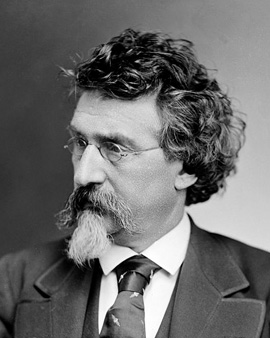The photographs of Mathew Brady became icons of American identity. One of his portraits of Abraham Lincoln has entered the collective memory of the world. Today, it is one of the best known and most widespread images of all. It adorns the five-dollar note and is a symbol of American capitalism. Of the 19 presidents of the USA between 1825 and 1896, Brady portrayed 18, with only the 9th president, William Henry Harrison, not included. He died in office, three days before the official photo session with the well-known portraitist. His name, however, is linked to one of the most traumatic events in American history, the American Civil War of 1861-1865.
Brady was born in New York as the son of Irish immigrants and began an apprenticeship with the portrait painter William Page at the age of 16. Here he developed his passion for the human physiognomy, which only found its artistic expression after another encounter with Samuel F. B. Morse. With Morse, Brady was confronted with the methods of daguerreotype, the first technical imaging process. He was fascinated by the technical imaging of human beings and over the next decades he actively participated in the development of photography and also changed imaging technologies several times. In addition to commissioned works in his photo studio opened in New York, Brady worked on a "Gallery of Illustrious Americans", which established his reputation and earned him a number of international awards as a photographer.
With the outbreak of the American Civil War in 1861, the photographer's subject changed. In the beginning he tried to earn money with the Civil War by an advertising campaign, in which he offered families to photograph their sons before they went to war. Under the motto "You can tell, how soon it may be too late", he worked with the families' fear of loss. But then he found his artistic calling and established himself as a war photographer who documented the battles and human sacrifices of war on both sides. He received permission from Abraham Lincoln to accompany the Northern troops, but with the restriction that he had to pay for the financing himself. With his camera and portable darkroom, Brady moved into the direct battlefield and gave a face to the horror of the first technological war in human history. The project grew and by the end of the war in 1865 Brady employed a total of 17 assistants who had produced over 10,000 photographic plates. Brady invested over $100,000 in the campaign in the hope that the government would subsequently pay for the costs incurred. But after the end of the war, the cruelty of the battlefields became taboo and Brady was granted only $25,000 by the U.S. government in 1875. Brady died completely impoverished and blinded in New York, but his photographs of the American Civil War live on.
×





_photograph_by_Brady_in_-_(MeisterDrucke-1062690).jpg)
_photograph_by_Brady_in_-_(MeisterDrucke-1062690).jpg)
 - (MeisterDrucke-157674).jpg)
 - (MeisterDrucke-157674).jpg)
_(bw_photo)_-_(MeisterDrucke-36056).jpg)
_(bw_photo)_-_(MeisterDrucke-36056).jpg)
 - (MeisterDrucke-271002).jpg)
 - (MeisterDrucke-271002).jpg)
.jpg)
.jpg)
.jpg)
.jpg)
.jpg)
.jpg)
 (detail of 254703) - (MeisterDrucke-70188).jpg)
 (detail of 254703) - (MeisterDrucke-70188).jpg)
.jpg)
.jpg)
.jpg)
.jpg)
.jpg)
.jpg)
.jpg)
.jpg)
_-_(MeisterDrucke-313010).jpg)
_-_(MeisterDrucke-313010).jpg)
 - (MeisterDrucke-98849).jpg)
 - (MeisterDrucke-98849).jpg)
 - (MeisterDrucke-242725).jpg)
 - (MeisterDrucke-242725).jpg)
.jpg)
.jpg)
.jpg)
.jpg)
.jpg)
.jpg)
 - (MeisterDrucke-237446).jpg)
 - (MeisterDrucke-237446).jpg)
_-_(MeisterDrucke-315397).jpg)
_-_(MeisterDrucke-315397).jpg)
.jpg)
.jpg)
.jpg)
.jpg)
.jpg)
.jpg)
.jpg)
.jpg)
.jpg)
.jpg)
.jpg)
.jpg)
.jpg)
.jpg)
.jpg)
.jpg)
.jpg)
.jpg)
_-_(MeisterDrucke-42858).jpg)
_-_(MeisterDrucke-42858).jpg)
.jpg)
.jpg)
.jpg)
.jpg)
.jpg)
.jpg)
.jpg)
.jpg)
 American Politician 32nd US Secretary of State (albumen photo) - (MeisterDrucke-146435).jpg)
 American Politician 32nd US Secretary of State (albumen photo) - (MeisterDrucke-146435).jpg)
.jpg)
.jpg)
.jpg)
.jpg)
.jpg)
.jpg)
.jpg)
.jpg)
 - (MeisterDrucke-237298).jpg)
 - (MeisterDrucke-237298).jpg)
 - (MeisterDrucke-63401).jpg)
 - (MeisterDrucke-63401).jpg)
.jpg)
.jpg)
 - (MeisterDrucke-107009).jpg)
 - (MeisterDrucke-107009).jpg)
.jpg)
.jpg)
.jpg)
.jpg)
.jpg)
.jpg)
.jpg)
.jpg)
.jpg)
.jpg)
.jpg)
.jpg)
.jpg)
.jpg)
.jpg)
.jpg)
.jpg)
.jpg)
.jpg)
.jpg)
.jpg)
.jpg)
.jpg)
.jpg)
 - (MeisterDrucke-104563).jpg)
 - (MeisterDrucke-104563).jpg)
.jpg)
.jpg)
_-_(MeisterDrucke-230972).jpg)
_-_(MeisterDrucke-230972).jpg)
.jpg)
.jpg)
 - (MeisterDrucke-180796).jpg)
 - (MeisterDrucke-180796).jpg)
.jpg)
.jpg)
.jpg)
.jpg)
 - (MeisterDrucke-75879).jpg)
 - (MeisterDrucke-75879).jpg)
_-_(MeisterDrucke-313257).jpg)
_-_(MeisterDrucke-313257).jpg)
.jpg)
.jpg)
.jpg)
.jpg)
 - (MeisterDrucke-183399).jpg)
 - (MeisterDrucke-183399).jpg)
.jpg)
.jpg)
_-_(MeisterDrucke-1594875).jpg)
_-_(MeisterDrucke-1594875).jpg)
.jpg)
.jpg)
 - (MeisterDrucke-199597).jpg)
 - (MeisterDrucke-199597).jpg)
.jpg)
.jpg)
 - (MeisterDrucke-242492).jpg)
 - (MeisterDrucke-242492).jpg)
.jpg)
.jpg)
 - (MeisterDrucke-363903).jpg)
 - (MeisterDrucke-363903).jpg)
_-_(MeisterDrucke-109165).jpg)
_-_(MeisterDrucke-109165).jpg)
.jpg)
.jpg)
_-_(MeisterDrucke-648720).jpg)
_-_(MeisterDrucke-648720).jpg)
.jpg)
.jpg)
.jpg)
.jpg)
 - (MeisterDrucke-300207).jpg)
 - (MeisterDrucke-300207).jpg)
.jpg)
.jpg)
.jpg)
.jpg)
.jpg)
.jpg)
.jpg)
.jpg)
.jpg)
.jpg)
.jpg)
.jpg)
 - (MeisterDrucke-185720).jpg)
 - (MeisterDrucke-185720).jpg)
 - (MeisterDrucke-300686).jpg)
 - (MeisterDrucke-300686).jpg)
.jpg)
.jpg)
.jpg)
.jpg)
.jpg)
.jpg)
.jpg)
.jpg)
.jpg)
.jpg)
.jpg)
.jpg)
.jpg)
.jpg)
.jpg)
.jpg)
.jpg)
.jpg)
.jpg)
.jpg)
_-_(MeisterDrucke-305535).jpg)
_-_(MeisterDrucke-305535).jpg)






